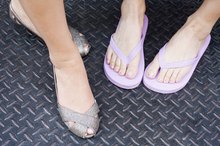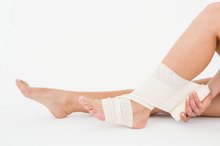What Causes Pain to the Back of Your Ankle & Heel When You Walk?
Pain at the back of your ankle and heel during walking may indicate muscle tightness, tendinitis or ankle impingement syndrome. Your pain may be described as achy, sharp or stabbing and can be accompanied with swelling and joint stiffness. Treatment includes rest, ice, compression and elevation, commonly given the acronym RICE. For persistent or worsening pain, consult your physician.
Tendinopathies
Your Achilles tendon attaches your calf muscles to the back, or posterior, aspect of your ankle and heel. Other tendons around your ankle include your peroneal, posterior tibial and flexor hallucis longus tendons. Tendinopathies is a general term for tendon injuries or inflammation; these may also be called tendinitis and tendinosis. Your age, muscle tightness and previous injuries increase your risk of developing tendon injuries. The most common symptom is pain on the back of your heel and ankle, which can increase with activities like walking. Additional symptoms include swelling, stiffness and thickening of your tendon. Chronic inflammation of your tendon may also increase your risk of a tendon strain or tear.
- Your Achilles tendon attaches your calf muscles to the back, or posterior, aspect of your ankle and heel.
- Chronic inflammation of your tendon may also increase your risk of a tendon strain or tear.
Posterior Impingement Syndrome
My Heel Hurts & I Have Sharp Pain When I Walk
Learn More
Posterior impingement syndrome is when soft tissue, like tendons, is compressed on the back of your ankle between your heel bone and tibia, or shin bone. According to research published in 2006 in the journal "Foot and Ankle Clinics of North America," runners and dancers are at a higher risk of developing posterior impingement syndrome. Impingement can lead to pain, swelling and numbness or tingling. Walking, running and dancing can further aggravate your symptoms.
- Posterior impingement syndrome is when soft tissue, like tendons, is compressed on the back of your ankle between your heel bone and tibia, or shin bone.
- According to research published in 2006 in the journal "Foot and Ankle Clinics of North America," runners and dancers are at a higher risk of developing posterior impingement syndrome.
Ankle Sprain
An ankle sprain is when you twist your ankle, causing damage to your ligaments such as your posterior tibiofibular ligament. An ankle sprain can be a minor over-stretching, a partial tear or a complete rupture of one or more ankle ligaments. Symptoms include swelling, pain and bruising around your ankle and heel. A severe ankle sprain also causes joint instability, which can make walking and other activities painful and difficult.
- An ankle sprain is when you twist your ankle, causing damage to your ligaments such as your posterior tibiofibular ligament.
Osteoarthritis
Groin & Hip Pain Upon Standing & Walking
Learn More
Osteoarthritis is the wearing-away or deterioration of the cartilage in your ankle. High-impact activities like jumping, a previous ankle injury such as an ankle sprain and chronic inflammation may increase your risk of developing osteoarthritis. Symptoms include grinding or catching, swelling, stiffness, joint instability and pain around your ankle and heel. Advanced osteoarthritis may lead to bony projections or bone spurs, which can cause further pain.
- Osteoarthritis is the wearing-away or deterioration of the cartilage in your ankle.
- High-impact activities like jumping, a previous ankle injury such as an ankle sprain and chronic inflammation may increase your risk of developing osteoarthritis.
Treatment and Prevention
Rest the affected area, ice it, wear a compression wrap and elevate your ankle above your heart to reduce swelling and pain. Take nonsteroidal anti-inflammatory drugs such as ibuprofen to further reduce pain and swelling. Your physician may also recommend using crutches during walking, corticosteroid injections, physical therapy and surgery. To prevent further pain and injury of your ankle and heel, stretch before and after exercise, increase the intensity and duration of exercise slowly and maintain a healthy weight. Exercises such as single-leg balancing and calf raises may also help maintain ankle strength and stability and prevent reinjury.
- Rest the affected area, ice it, wear a compression wrap and elevate your ankle above your heart to reduce swelling and pain.
- Your physician may also recommend using crutches during walking, corticosteroid injections, physical therapy and surgery.
Related Articles
References
- “Foot and Ankle Clinics of North America”; Anterior and Posterior Ankle Impingement; C. Niek van Dijk, M.D., Ph.D.; 2006
- “Journal of the Royal Society of Medicine”; Achilles Tendinopathy: Aetiology and Management; Nicola Maffulli, M.D., et al.; October 2004
- “American Family Physician”; Tendinopathies of the Foot and Ankle; Michael R. Simpson, D.O., et al.; Nov. 15, 2009
- “American Family Physician”; Management of Ankle Sprains; Michael W. Wolfe, M.D., et al.; Jan. 1, 2001
- “Rheumatic Disease Clinics of North America”; The Management of Osteoarthritis: An Overview and Call to Appropriate Conservative Treatment; David J. Hunter, M.B.B.S., Ph.D., et al.; 2008
- American Academy of Orthopaedic Surgeons. OrthoInfo. Achilles Tendinitis. Reviewed June 2010.
- American Academy of Orthopaedic Surgeons. OrthoInfo. Arthritis of the Foot and Ankle. Reviewed March 2015.
- American Academy of Orthopaedic Surgeons. OrthoInfo. Ankle Fractures (Broken Ankle). Reviewed March 2013.
- Arthritis Foundation. Arthritis and Diseases that Affect the Ankle.
- Robati S, Porter K, Shahid M, Crompton T, Sandiford N. Ankle osteomyelitis: an unusual presentation. JRSM Short Rep. 2013;4(6):35. doi:10.1177/2042533313476682.
- Merck Manual Consumer Version. Tarsal Tunnel Syndrome. Revised March 2018.
- U.S. National Library of Medicine. MedlinePlus. Common peroneal nerve dysfunction. Reviewed August 7, 2017.
- Mascard E, Gaspar N, Brugières L, Glorion C, Pannier S, Gomez-brouchet A. Malignant tumours of the foot and ankle. EFORT Open Rev. 2017;2(5):261-271. doi:10.1302/2058-5241.2.160078
- Tiemstra JD. Update on acute ankle sprains. Am Fam Physician. 2012;85(12):1170-6.
- American Academy of Orthopaedic Surgeons. OrthoInfo. Sprained Ankle. Reviewed February 2016.
- Arthritis Foundation. Lab Tests for Diagnosing Ankle Problems.
- Merck Manual. Professional Version. Cellulitis. Reviewed September 2019.
- American Academy of Orthopaedic Surgeons. OrthoInfo. Compartment Syndrome. Reviewed October 2009.
- American Academy of Orthopedic Surgeons. (n.d.). Arthritis of the Foot and Ankle.
- American Academy of Orthopedic Surgeons. (n.d.). Sprained Ankle.
- Koehler SM, Eiff P. (2018). Overview of Ankle Fractures in Adults. Asplund CA, ed. UpToDate. Waltham, MA: UpToDate Inc.
- Mascard E, Gaspar N, Brugieres L, Glorion C, Pannier S, Gomez-Brouchet A. Malignant tumours of the foot and ankle. EFORT Open Rev. 2017 May;2(5):261-71.
- Robati S, Porter K, Shabid M, Crompton T, Sandiford N. Ankle osteomyelitis: An unusual presentation. JRSM Short Rep. 2013 Jun;4(6):35.
Writer Bio
Since 2007 Hannah Mich has written e-newsletters and been published in the "Missouri Journal of Health, Physical Education, Recreation and Dance." She has a Bachelor of Science in exercise science from Truman State University and a Master of Education in applied kinesiology from the University of Minnesota.








